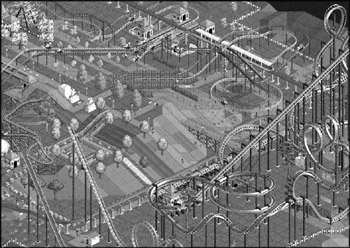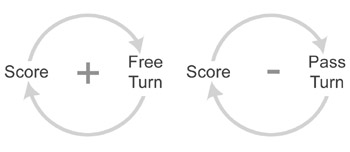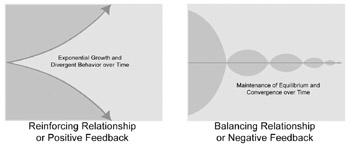Interacting With Systems
|
| < Day Day Up > |
|
-
How much information do players have about the state of the system?
-
What aspects of the system do players control?
-
How is that control structured?
-
What type of feedback does the system give the players?
-
How does this affect the gameplay?
Information structure
In order for players to make choices about how to proceed in a game, they need information about the state of the game objects and their current relationships to each other. The less information players have, the less informed their choices will be. This affects the sense of control they have over their progress. It can also add to the amount of chance in the system and allow space for misinformation or deception as a part of the gameplay.
To understand the importance of information in a game system, think about what types of information you're given in some of the games that you like to play. Do you know the effect of every move you make? What about the other players? Is there information that you only have access to some of the time?
How information is structured in a game has a large influence on how players come to their decisions. In classic strategy games like chess and Go, the players have complete information about the game state. This is an example of an open information structure. An open structure emphasizes player knowledge and gives full disclosure on the game state. It will generally allow for more calculation-based strategy in the system. If this is the type of play you want to encourage in your system, you need to make sure that important information is available to your users.
On the other hand, if you want to create play situations built around guessing, bluffing, or deceiving, you may want to consider hiding information from players. In a hidden information structure, players do not receive certain data about their opponent's game state. A good example of this is the 5-card stud variation of poker-in which all cards are dealt facing down. In this game, the only information players have about their opponents' hands is how many cards they are dealt and the way in which they bet. This hidden information structure allows for a different type of strategy to develop-one based on social cues and deception rather than calculation. And it tends to appeal to an entirely different type of player.
Exercise 5.7: Hidden Information
Many strategy games have open information structures that allow the players access to perfect information about the game state. Examples are chess, checkers, Go, mancala, etc. Take a game with an open information structure and change the system so that there's an element of hidden information. You may need to add new concepts to the game to accomplish this.
Test your new design. How does adding hidden information change the nature of the strategy? Why do you think this is so?
Many games use a mixture of open and hidden information, so that players are given some data about the state of their opponent's game, but not all. An example of such a mixed information structure might be the '7-card stud' variation of poker, where several cards are dealt down and several up over the course of the betting cycle, giving players only partial information about their opponents' hands. Another example of a mixed information structure is blackjack, for the same reasons.
The amount of information that players receive about their opponents' states often changes during the course of the game. This may because they have learned information by interacting with their opponents, or it may be because the concept of a dynamic information structure is built into the game. For example, real-time strategy games, like the WarCraft series, use the concept of 'fog of war' to provide dynamically changing information to players about their opponents' status. In this game, players can see the state of their opponents' territory if they move a unit into that territory. Once they move the unit out of the territory, the information freezes until another unit ventures back to the territory.
A dynamically changing information structure provides an ever-shifting balance between strategy based on knowledge, and strategy based on cunning and deceit. For the most part, this type of advanced information structure has only been possible since the advent of digital games and the computer's ability to orchestrate the complex interactions between players.
Exercise 5.8: Information Structures
What type of information structures are present in Unreal Tournament, Age of Empires, Jak II, Madden 2004, Lemmings, Scrabble, Mastermind, and Clue? Do they have open, hidden, mixed or dynamic information structures? If you don't know one of the games, pick a game that we haven't mentioned and substitute it.
Control
The basic controls of a game system are directly related to its physical design. Boardgames or card games offer control by direct manipulations of their equipment. Computer games may use a keyboard, mouse, joystick, or alternate types of control devices. Platform games usually provide a proprietary controller. Arcade games often use game-specific controls. Each of these types of controls is best suited to certain types of input. Because of this, games that require specific input types have been more successful in some game platforms than others. For example, games that require text entry have not been as popular on consoles as they have been on PCs.
The range of control types for games is extreme, everything from pencil and paper to flight simulations with mock cockpits. The arcade simulation games of Yu Suzuki, for example, offer realistic controls shaped like full-scale motorcycles and racing cars. Some games have as their goal to make control of game systems as realistic and responsive as possible. Others provide a more abstract, less-realistic control system.
One type of control system is not inherently better than another. What matters is whether or not the control system is well suited for the game experience, and it's the job of the designer to determine this. We encourage you to think about the games you like to play. What type of controls do you enjoy? Do you prefer to have direct control over the game elements, such as you might have when moving your character through a 3-D shooter? Or indirect control, as in a game like SimCity? Do you prefer real-time control, like in War- Craft, or turn-based control, as in Warlords II? These decisions will have a huge impact on what type of game you design and how you go about structuring it.
Direct control of movement is a clear-cut way for players to influence the state of the game. Players may also have direct control over other types of input, like selection of items, directly presented choices, etc. Some games do not offer direct control, however. For instance, in a simulation game like Rollercoaster Tycoon, players do not have direct control over the guests at their theme park. Instead, players can change ride variables, trying to make certain rides more attractive by lowering price, increasing throughput, or improving the ride design. This 'indirect control' offers ways for players to influence the state of the game that is one step removed from the desired changes and provides an interesting type of challenge within certain game systems.
When the designer chooses what type of control to offer to players, he is deciding a very important part of the game. This decision forms the top-level experience that players will have with the system. Control often involves a repetitive process or action performed throughout a game. If this basic action is hard to perform, unintuitive, or just not enjoyable, the player may stop playing the game altogether.
In addition to deciding the level of control, the designer also needs to consider restricting control of some elements completely. As we discussed when we talked about designing conflict, games are made challenging by the fact that the players cannot simply take the simplest route to a solution. This is true in terms of designing controls as well. Some games allow a high degree of freedom in terms of player control. For example, a 3D shooter allows for spontaneous, real-time movement throughout the environment. Other games restrain player control tightly, using this structure to provide part of the challenge. An example of this would be a turn-based strategy game, like Go or chess.
How do you decide what controls to allow players and what not to allow? This is a central part of the design process. You can see the impact different levels of input have on games if you look at a familiar game and imagine how it would work if you took away some of the player input.
For example, let's look at a real-time strategy game like WarCraft II. In this game, the player selects certain units to mine gold, others to chop trees, etc. How many units are doing these tasks at any given time is a function of availability, but is basically under the player's control. What if this opportunity for control was taken away? Imagine how the system would work if the designer determined that system would always assign 50% of the available units to mine gold and 50% to chop trees. How would taking this input away from the player affect the system? Would it create too much balance between various players' resources? Would it take away some tedious parts of gameplay? Or would it take away critical resource management? These are questions a designer faces when thinking about how much and what type of control to give players into the system.
Exercise 5.9: Control
For the same games mentioned in Exercise 5.7, describe the methods of control they use: direct/indirect, real-time/turn-based. Are there any cases in which these distinctions are mixed?
Feedback
Another aspect of interaction with the system is feedback. When we use the word 'feedback' in general conversation, we often are just referring to the information we get back during an interaction-not what we do with it. But in system terms, feedback implies a direct relationship between the output of an interaction and a change to another system element. Feedback can be 'positive' or 'negative,' and it may promote divergence or balance in the system.

5.13 Indirect control: Rollercoaster Tycoon

Figure 5.14: Positive and negative feedback loops
Figure 5.14 shows example feedback loops for two different types of game scoring systems. In the first example, if a player scores a point, they get a free turn. This reinforces the positive effects of the scored point, creating an advantage for that player. A negative feedback loop, on the other hand, like that on the right, works against the effect of the point. In this example, every time a player scores a point, they must pass the turn to the other player. This has the effect of balancing the system between the two players, rather than allowing one player to get a larger advantage over the other.
'Positive' and 'negative' are somewhat loaded terms, and some systems theories use the terms 'reinforcing' and 'balancing' instead. Generally, reinforcing relationships are ones in which a change to one element directly causes a change to another element in the same direction. This may force the system toward one or the other extreme. By contrast, in balancing relationships, a change to one element causes a change to another in the opposite direction, forcing the system toward equilibrium.
For example, in the game Jeopardy! when a player answers a question correctly, they retain control of the board. This presumably gives the leading player an advantage in answering the next question, reinforcing their lead in the game and moving the system toward resolution in their favor. This is a reinforcing relationship, or loop. An example of the same type of relationship, but in the opposite extreme, would be if a Jeopardy! player who answered incorrectly was forced to sit out the next question. This is not a rule in the game, but if it were, it would reinforce the repercussions of answering a question wrong.
Reinforcing loops cause output that either steadily grows or declines. Many games use reinforcing loops to create satisfying risk/reward scenarios for players which drive the game toward an unequal outcome based on player choices. In order to keep the game from resolving too quickly however, balancing relationships are also used.
Balancing relationships, on the other hand, try to counteract the effects of change. In a balancing relationship, a change to one element results to a change in another element in the opposite direction. The classic example of a balancing relationship is in football. When one team scores, the ball is turned over to the other team. This gives a boost to the nonscoring team, attempting to balance the effects of the points won. If the advantage was given to the scoring team instead, it would be an example of a reinforcing relationship.

Figure 5.15: Reinforcing and balancing relationships over time
Some balancing relationships are not as easy to distinguish. For example, the boardgame Settlers of Catan has a procedure that attempts to create balance in the number of resources each player may hold at any one time. In this game, every time a seven is rolled with two six-side dice, any players holding more than seven cards in their hand must give up half of them. This has the effect of keeping prosperous players from becoming too powerful and resolving the game too quickly.
In order to improve gameplay, a good designer must be able to evaluate how quickly or slowly the game is progressing, understand if there are patterns to growth or contraction in the system caused by reinforcing loops, and know when and how to apply a balancing factor.
|
| < Day Day Up > |
|
EAN: 2147483647
Pages: 162